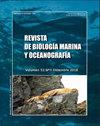墨西哥湾南部潮间带岩石壳(软体动物:Polyplacophora)群落的季节变化
IF 0.5
4区 生物学
Q4 MARINE & FRESHWATER BIOLOGY
引用次数: 3
摘要
墨西哥湾的南海岸通常是一个海岸平原,与岩石的突出物交替。本研究的目的是比较蒙特皮奥岩石海岸岩体在干旱和北方天气期间的群落结构,并提供优势种的相对生长数据。本研究的目的是评估在墨西哥北部海岸和墨西哥北部海岸的红树林中发现的物种。鉴定出6种:玫瑰鳞翅目、apiculata毛虫、Ischnochiton kaasi、pseudoliozonis鳞翅目、liozonis鳞翅目和andersoni棘翅目。2个季节的物种丰富度(S= 4)和Shannon多样性(干旱和北方分别为1.36和1.29位ind1)非常相似;在这两个时期,物种的数量都在增加,这表明物种的季节性变化很大(50%)。这种季节性的动态是由于岩石基底的中断,这将不允许种群在北方的影响后迅速恢复。生物密度很低(英语stract:南墨西哥湾通常是一个沿海平原,岩石海岸分散分布。= =地理= =根据美国人口普查,该地区的总面积为,其中土地和水(0.984平方公里)是土地,(0.984平方公里)是水(0.984平方公里)。在潮间带,沿着100 × 2米的样带进行采样,收集了83个个体。鉴定出6种:玫瑰鳞翅目、apiculata Chaetopleura、Ischnochiton kaasi、pseudoliozonis鳞翅目、liozonis鳞翅目和andersoni。物种丰富度(S= 4)和Shannon多样性(旱季和风暴季分别为1.36和1.29位ind-1)在两个季节之间非常相似;= =地理= =根据美国人口普查,该县的总面积为,其中土地和(1.2%)水。= =地理= =根据美国人口普查,该地区的总面积为,其中土地和(2.641平方公里)水。个人密度低(本文章由计算机程序翻译,如有差异,请以英文原文为准。
Variaciones estacionales de la comunidad de quitones (Mollusca: Polyplacophora) en una zona intermareal rocosa del sur del Golfo de México
espanolResumen: La costa sur del Golfo de Mexico es tipicamente una llanura costera que alterna con salientes rocosas. Este estudio tuvo como objetivo comparar la estructura comunitaria de los quitones del litoral rocoso de Montepio, durante los periodos meteorologicos de secas y nortes y proporcionar datos sobre el crecimiento relativo de las especies dominantes. Se muestreo sobre un transecto de 100 x 2 m en la zona intermareal y se recolectaron 83 individuos. Se identificaron 6 especies: Lepidochitona rosea, Chaetopleura apiculata, Ischnochiton kaasi, Lepidochitona pseudoliozonis, Lepidochitona liozonis y Acanthochitona andersoni. Las 2 epocas fueron muy similares en riqueza de especies (S= 4) y diversidad de Shannon (1,36 y 1,29 bits ind-1 en secas y nortes); sin embargo, solo 2 especies ocurrieron en ambos periodos, lo que indica un fuerte recambio estacional de especies (50%). Esta dinamica estacional se deberia a la discontinuidad del sustrato rocoso, que no permitiria una recuperacion rapida de las poblaciones despues del impacto de los nortes. La densidad de organismos fue baja ( EnglishAbstract: The southern Gulf of Mexico is typically a coastal plain where rocky shores are scattered distributed. The goal of this study was to compare the chiton community structure of the rocky shore of Montepio during the dry and ‘nortes’ (stormy) weather periods, and to gather data on the relative growth of the dominant species. Sampling was carried out along a transect of 100 x 2 m in the intertidal zone and 83 individuals were collected. Six species were identified: Lepidochitona rosea, Chaetopleura apiculata, Ischnochiton kaasi, Lepidochitona pseudoliozonis, Lepidochitona liozonis and Acanthochitona andersoni. Species richness (S= 4) and Shannon diversity (1.36 and 1.29 bits ind-1 in dry and stormy seasons) were very similar between the 2 seasons; however, only 2 species occurred in both periods, suggesting a strong seasonal exchange of species (50%). This seasonal dynamics could be due to the discontinuity of the rocky substrate, which would not allow a rapid recovery of the populations after the impact of storms. Density of individuals was low (
求助全文
通过发布文献求助,成功后即可免费获取论文全文。
去求助
来源期刊
CiteScore
0.70
自引率
0.00%
发文量
41
审稿时长
12 months
期刊介绍:
Publicar desde una perspectiva científica, artículos originales, decididos por un proceso de revisión por pares, invitando a expertos de reconocido prestigio en el área. Los trabajos publicados se caracterizarán por su solidez teórica-metodológica, actualidad y relevancia para las ciencias marinas.
Se reciben trabajos inéditos derivados de la investigación científica realizada en ambientes marinos y estuarios, en formato de Revisión, Artículos, Notas Científicas, y Obituarios en las siguientes disciplinas::
Biología-Ecología marina
Oceanografía física, química y biológica
Contaminación marina
Geología marina
Sistemática, Faunística y Biogeografía Marina
Manejo Costero
Acuicultura marina
Pesquería marina.

 求助内容:
求助内容: 应助结果提醒方式:
应助结果提醒方式:


